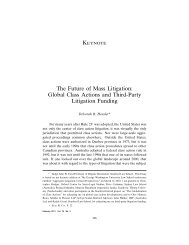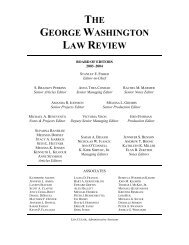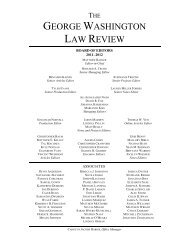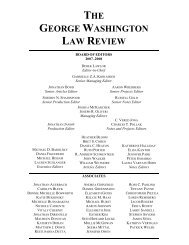View PDF - The George Washington Law Review
View PDF - The George Washington Law Review
View PDF - The George Washington Law Review
Create successful ePaper yourself
Turn your PDF publications into a flip-book with our unique Google optimized e-Paper software.
886 <strong>The</strong> <strong>George</strong> <strong>Washington</strong> <strong>Law</strong> <strong>Review</strong> [Vol. 78:870<br />
Although continued use of the Penn Central analysis offers property<br />
owners more protection than recourse to Lucas and Loretto<br />
alone, the balancing test remains deficient. <strong>The</strong> first deficiency in<br />
Penn Central is that the Court never actually settles on a clear threefactor<br />
test. 94 To the contrary, the opinion only identifies certain factors<br />
to consider and by no means devises a determinative test for regulatory<br />
takings. 95<br />
Second, as the various contrasting definitions of the character factor<br />
demonstrate, the Penn Central balancing test “is so vague and indeterminate<br />
that it invites unprincipled, subjective decision making by<br />
the courts.” 96 A comparison of the facts and decisions in Penn Central<br />
and in Florida Rock Industries, Inc. v. United States, 97 a decision of the<br />
Court of Federal Claims, illustrates this point. In Penn Central, a regulation<br />
concerning historical landmarks prohibited the owners of<br />
Grand Central Terminal from constructing office buildings above the<br />
terminal. 98 <strong>The</strong> regulation’s economic impact on the owners was significant<br />
because the future office space would have been in high demand.<br />
99 Additionally, the owners’ distinct investment-backed<br />
expectations were substantially frustrated because the regulation had<br />
not yet been promulgated when the owners purchased the property. 100<br />
<strong>The</strong> property owners in Florida Rock suffered a similar hardship<br />
as a result of a denial of a wetland permit needed to mine limestone<br />
from their property. 101 <strong>The</strong> economic impact was comparatively large,<br />
and because the Clean Water Act had not yet been enacted at the<br />
time of the owners’ purchase, their distinct investment-backed expectations<br />
were similarly frustrated. 102 <strong>The</strong> outcomes, however, were<br />
vastly different; the Supreme Court rejected a regulatory takings<br />
advancement test should not be taken as rejection of such considerations of means and ends in<br />
takings law”).<br />
94 See Penn Cent. Transp. Co. v. New York City, 438 U.S. 104, 124 (1978) (identifying<br />
“several factors that have particular significance” in the ad hoc inquiries conducted by the<br />
Court).<br />
95 See id.<br />
96 Echeverria, supra note 25, at 7.<br />
97 Fla. Rock Indus., Inc. v. United States, 45 Fed. Cl. 21 (1999).<br />
98 See Penn Cent., 438 U.S. at 115–17.<br />
99 See id. at 116.<br />
100 See id. at 109, 113 (noting that the New York preservation law was adopted in 1965 and<br />
Penn Central opened in 1913).<br />
101 See Fla. Rock, 45 Fed. Cl. at 25.<br />
102 See id. at 29, 36–39.









